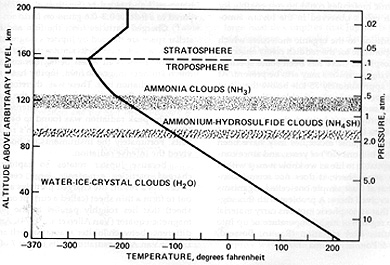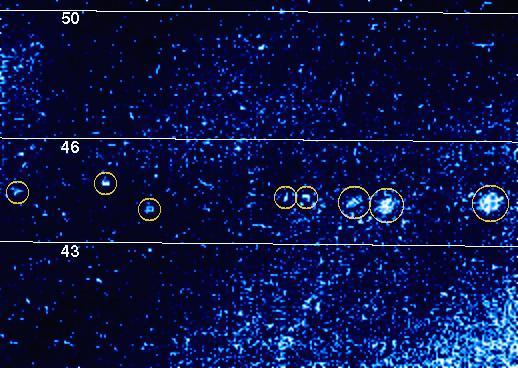

Jupiter
After the Voyagers, Jupiter has been revisited in the '90s. The primary objective for the Galileo mission was to penetrate the Jovian atmosphere. This spacecraft, launched on October 13, 1989, separated its probe from the Orbiter on December 7, 1995. The probe’s initial velocity on entering was about 106,000 km/hr (65,868 mph), but it then slowed greatly, due to atmospheric friction aided by a deployed parachute. It transmitted data for 57 minutes, as it descended in excess of 150 km (93.2 mi), where the pressure exceeded 24 bars (23.7 atm) at a temperature around 150° C. It encountered no thick, dense clouds, and it detected almost no oxygen or water. The helium and neon levels were below what was expected. The data overall suggested the probe may have entered at an anomalous hot spot, with abnormal cloud conditions. As it observes Jupiter, the Orbiter has found evidence of large thunderstorms, with rain, and some lightning. The Orbiter also monitors the Galilean satellites, taking close-ups of their surfaces that surpass those of Voyager.
Our tour begins with Jupiter, shown here in full disk images taken by Voyager 1 (top), enhanced to bring out various color tones and (bottom) taken from the Galileo spacecraft that is a closer approximation to the true color of this planet's atmospheric surface.
The most obvious features are the colored bands (from chemical reactions), in which the darker reddish-browns are called belts (low pressure atmospheric motion) (temperatures around -147° C) and the lighter, more bluish are zones (higher pressure) (temperatures about -154° C). In Jupiter's northern hemisphere, jet winds at velocities up to 600 km/hr (420 mph) blow westward south of zones and north of belts and eastward north of zones and south of belts; this is reversed in the southern hemisphere. Global cloud decks include an outer layer of ammonia ice crystals, above a layer containing small amounts of ammonium hydrosulphide (NH4SH), and possibly a water ice crystal layer beneath. Upwelling in the belts may convert the NH4SH (perhaps including also phosphorus compounds) into the darker reds by photochemical reactions with sunlight. This profile diagram describes the pressure-temperature-composition relations in the jovian atmosphere:

A hallmark of Jupiter's atmosphere is the prominent Great Red Spot (GRS), an oval feature (25000 x 12000 km [15500 x 750 miles]) that has persisted at least since its discovery by telescope in the 17th century. The GRS is a high pressure disturbance caused by thermal convection that carries gases up to 8 km (5 miles) higher than its surroundings, thus cooling them; its anticyclonic winds move counterclockwise (in the southern hemisphere) as it drifts through the bands. The GRS experiences a complete rotation in about 6 days. The false color view below is a Voyager close-up of the GRS in which images made by the red and blue filters are enhanced relative to green which also helps to emphasize some of the swirls and plumes peripheral to it. Red areas are higher than blue above the level of the Jovian atmosphere that appears as a quasi-surface.
The bands and convection plumes show temperature differences that broadly correlate with the patterns these atmospheric features assume. This correlation is evident in the Galileo Orbiter view, below, of a segment of bands and spots, in which the temperatures derived from the photopolarimeter divide into warmer (yellow) and somewhat cooler (orange-red to black) zones.
19-53:
The Jovian atmosphere is not only dynamic and turbulent but is electrically
charged, as evident from this next view that shows lightning-like discharges,
imaged when the Orbiter is looking at the nightside of Jupiter's outer atmosphere.
These are the first visible lightning flashes seen on another planet.

The Orbiter also observed aurora effects as rings at the north and south magnetic
poles. The view below shows a Galileo visible image of the planet, on which
are two superimposed insets made with the UV camera on the spacecraft.
Ultraviolet auroral light comes from emissions resulting from excited ions and electrons emanating from the innermost satellite, Io, released during volcanic activity (see the next page) that Jupiter’s magnetic field captured and concentrated in the polar regions.
Jupiter's ring system is more nebulous than Saturn's, as evident in this Voyager image.
The ring's inner edge begins at about 123,000 km (76,432 mi) from the planet's center. Its fine particles, still effective as sunlight reflectors, form a continuous band about 5,200 km (3,231 mi) wide and 30 km (18.6 mi) thick that shows no conspicuous gaps.

Primary Author: Nicholas M.
Short, Sr. email: nmshort@epix.net
Contributor Information
Last Updated: September '99
Site Curator: Nannette Fekete